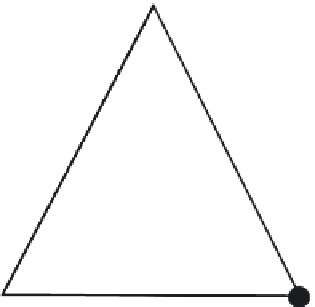Biology Reference
In-Depth Information
FIGURE 4.3
The centroid of the triangle in
Figure 4.2
. The
coordinates of the centroid are the averaged coordinates of the
three vertices.
0, 1
Centroid
(0.0,
0.333)
1,
1
1,
1
(positive or negative) to the
X
- and
Y
-coordinates. To do this we first calculate the
X
and
Y
centroid coordinates of the configuration matrix
as in
Equation 4.5
, then subtract the
centroid positions from each coordinate to form the centered configuration matrix
X
XC
:
2
4
3
5
ð
X
1
X
C
Þð
Y
1
Y
C
Þ
2
2
ð
X
2
X
C
Þð
Y
2
Y
C
Þ
2
2
XC
5
(4.6)
^
^
ð
X
K
2
X
C
Þð
Y
K
2
Y
C
Þ
Two configuration matrices that differ only in the position of the centroid are not differ-
ent shapes (they differ only by translation, one of the operations that do not alter shape).
Size of a Configuration Matrix
Before we can coherently talk about
scale
, we need to define what we mean (mathemati-
cally) by the term
size
. For configuration matrices, a number of different, non-equivalent
size measures have been used. It is not possible to say that one size measure is “correct”
or “preferable”, but it is important to explain the consequences of making a particular
choice. The most commonly used size measure in geometric morphometrics is called
cen-
troid size
, which is favored because it does not induce a correlation between size and shape
(at least under some error models, Bookstein, 1991), hence we restrict our discussion of
size to that particular measure. The centroid size (
CS
) of a configuration (
X
) is:
t
X
X
K
M
2
CS
ðXÞ
5
1
ðX
2
C
j
Þ
(4.7)
ij
i
1
j
5
5
where the sum is over the rows
i
and columns
j
of the matrix
X
ij
is a standard notation
from linear algebra specifying the value located on the
i
th row and
j
th column of the
X
.









